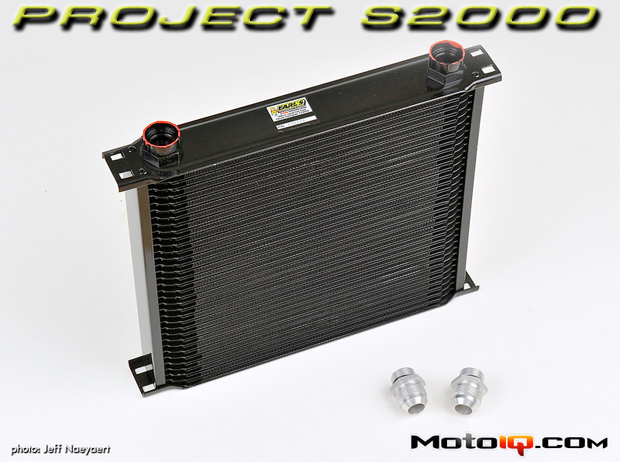,
 |  |
| When I bought the SPAL fan, I also bought an optional mounting kit. It turns out the mounting kit is basically a set of fancy plastic zip ties. I wasn’t really digging it, so I fabbed up a brace/bracket out of 1/8″ thick aluminum (bought at Home Depot) to clamp the fan down. I used some more of the sticky rubber strip between the aluminum brace and the fan. |
 |
| The oil cooler in its new home with the SPAL fan attached. I made the mounting brackets out of the aluminum strips again. The Earl’s Pro-Lite 350 lines are routed under the chassis cross member to the Mocal sandwich adapter. |
 |
| The view of the bottom. The oil cooler is resting on the two tabs previously used to locate the bottom of the stock fan. I spent a fair amount of time tweaking the braces up top to try to evenly distribute the weight between the braces and the tabs at the bottom of the radiator. More of the rubber strips here! |
 |
| No clearance issues here with the SPAL slim fan in place. |
 |
| How everything looks with the stock airbox reinstalled. And in case you were wondering, the blue painters tape is keeping the foam strip from getting blown out. |




17 comments
Why did you choose such a big oil cooler? the aftermarket does not offer such large applications.
Does it have to do with the flow rate of the s2000’s oil pump at high rpm?
I have oil cooler setrab of 18 lines and I see that after 5 minutes on the track the pressure drops to 64psi in vtect and the temperature to 233f
my car is supercharger kraftwerks and the oil cooler is located behind the supercharger intercooler
thanks
Part of the reason was because I put the oil cooler behind all the other heat exchangers, so it was getting the hottest air. Check out the article that is Part 23: Testing air temps through coolers and vents. I also only had one chance to do this setup without testing various combinations, so I went large to be safe. The benefits being more cooling, greater oil capacity, and less pressure drop. I don’t think I’ve ever seen below 75-80psi in the VTEC transition with oil temps at 240F.
my car have kraftwerks kit, please recommend configuration for oil cooler
Use an oil cooler with more rows. The greater number of rows, the lower the pressure drop and the more cooling. Also, what size lines are you using? I’m using -12. Lots of kits use -8 which is too small in my opinion. I would say at least -10.
Why does a greater number of rows equate to a lower drop in oil pressure? Is it because the greater number of rows allows for more paths for the oil to flow and thus less restriction to flow? Also, If I were to take a 30 row oil cooler core and make it into a triple pass where each pass has 10 rows, would that create a pressure drop equivalent to using a 10 row single pass cooler?
Pressure drop is a function of velocity and distance. Pressure drop increases to the square of velocity. And the longer the distance, the greater the pressure drop. So with more rows, you have more flow area, which reduces the velocity for the same mass flow rate.
A 10-row single pass would have less pressure drop than a 30-row triple pass, assuming the cores are the same width. This is because in the 30-row triple pass, the flow distance is triple the 10-row assuming the cores are the same width. And there’s going to be additional pressure drop each time the oil has to make a turn in the triple pass.
Ok that makes sense. Thank you!
what oil use in your car?
Motul 300V 5w-30
I use a line of 16 lines behind the intercooler of my kraftwerks kit and the car easily goes up to 240f.
ask, if I add one of 42 lines behind the radiator with a fan, the temperature will I be able to control it better? What do you recommend doing to keep control of the oil temperature of my car?
The water temperature is stable at 220f
Bigger oil cooler will certainly help. But you also need to address your coolant temps which are too high. Consider that that fans turn on at 212F. Sure, you CAN run at 220F, but it reduces the reliability of your engine and hurts power. My car is naturally aspirated, but coolant never goes over 190F even when I did track days in 103F temps. Make sure you have your heat exchangers well sealed (I used foam stuffed around them) and you certainly need a vented hood if you don’t have one already.
hello I have a question I am using the original car water radiator thermostat, would you recommend changing the sensor to a mishimoto of less temperature? I use the street car too
No, changing to a lower temp thermostat does nothing for reducing temps at steady state conditions. It just delays how quickly the temp will max out.
A friend suggested to me a rather convelling idea about oil cooling: If for example we keep the original donut (oil cooler) to circulate water (circuit with a radiator on the bumper, and an electric pump that activates with a mano connected to the oil temperature) .. What do you think?
Yup, should work just fine. Keep in mind the OEM setup is circulating 190degF coolant. If you have a separate circuit with front mounted radiator, it should cool the coolant down close to ambient. So figure it’ll be at least 80degF cooler coolant compared to the OEM setup. You might need a variable speed pump to regulate the oil temp and not cool it too much under everyday driving conditions.
Any updates on how this is performing at the track? How is the oil temperature holding up?
https://motoiq.com/project-s2000-track-testing-revised-kw-clubsports-and-earls-oil-cooler/
https://motoiq.com/project-s2000-part-19-ram-air-plus-hot-air-testing/6/